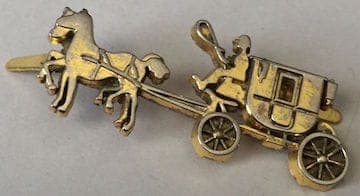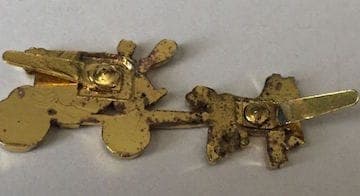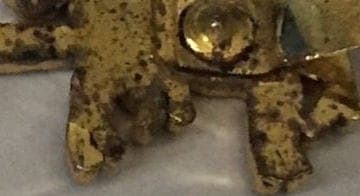
-----
How long Gold Plating over brass will last? Will the zinc discolor plating?
< Prev. page (You're on the last page of this topic)
June 24, 2017
Q. Hello,
I found an old Coach coach and carriage metal cast decoration, perhaps from a Coach purse or suitcase. The original 18K gold finish has worn off in some areas and the back of the piece appears tarnished (dark brown tarnish/staining). I believe the main component is brass. How would I go about replating it? Would the original finish have to be stripped down/removed completely before replating?
Thanks,
Lisa



- Lutz, Florida USA
Q. I want to purchase a jewelry set but I am not sure if 14K Gold over brass is worth buying.
katrina carter- carrollton, Georgia US
December 14, 2017
A. Hi Katrina. Unfortunately, ad copy is designed to entice you to buy, not to technically inform you about the durability of the item. There are dozens of variables, and no practical way for a consumer to know the quality & longevity of the items they are buying except by relying on the integrity of the brand name and of the store.
Sorry, but I think that's just the way it is :-(
Regards,

Ted Mooney, P.E. RET
Striving to live Aloha
finishing.com - Pine Beach, New Jersey
Ted is available for instant help
or longer-term assistance.
December 2017
January 10, 2018
Q. Hi, I'm trying to buy jewelry supplies from China and I would like to know which of the following descriptions is better to try (talking about quality and durability). I'm from Mexico and most of the vendors use only 1 or 2 descriptive words to name the quality like 22k or 10k Gold Plated
-Rack plating brass
-Golden Tone Brass
-Color keeping Brass
-plating
-Gold Plating Brass
-Brass
-Real Gold Plated
I can tell that the quality is directly related to the coverage between the plating and the material, but without knowing the material, which would be my best option?
- Sonora, Mexico
Q. Hi, may I know if I want to do 1 micron rose gold plating, between silver and bronze which material is durable to hold the rose gold plating?
Serena tan- Kuala Lumpur, malaysia
January 16, 2018
A. Serena:
The durability of wear of your rose gold plate should be about the same over either since the plate is the same thickness. Rose gold already contains some copper so the substrate doesn't matter regarding tarnish.
Albuquerque, New Mexico
January 17, 2018
Q. My new gold plater (My amazing old one retired!) will not use nickel as an underplating for gold. He uses palladium ... is this effective for preventing the substrate (for me, usually copper, sometimes silver) from tarnishing the gold plating?
Also, he insists on a very high polish, or it will not look truly gold (My old player had no problems with the polish---he just warned that one would have gold plated scratches if not polished properly, but everything--the good, bad, and the ugly--always came out with a definite gold coating.
- - Bronx, New York, USA
January 21, 2018
|
A. Either nickel or palladium will stop diffusion from the under layer, however, nickel is irritating to some people's skin and that is why palladium is usually preferred.  Robert H Probert Robert H Probert Technical Services Garner, North Carolina  January 23, 2018 A. Hi Katharine, Albuquerque, New Mexico January 24, 2018 |
Q. Hi, I am having jewelry made in Thailand that is 24k gold plated brass. I want it to be nickel and lead free so I understand that a different metal needs to be used as a barrier. I'm not sure what their plating process is (I have asked).
My questions are:
1. Is it worth it for the gold plating to be 3 microns? (i.e. is there much difference btwn 2-3 microns? Will it last longer etc?)
2. How thick/many microns should the barrier plating be?
Thank you!
- Sydney, NSW Australia
February 19, 2018
A. Hello Ruby, a palladium undercoating would be expensive, especially if you are dealing with plated jewelry. Check into white bronze as a barrier between the brass and gold. Six microns of the white bronze should be sufficient. Gold thickness on plated jewelry is normally very thin (10 microinches.) If you want quality, 2 micron gold thickness is the way to go as the finish will last longer than a flash plate. Use a hard acid gold which will give you better wear resistance. Keep in mind that with a barrier plate the gold color will be much different than it is with a brass substrate. Color matching will have to be done. With the added process and thicker gold deposit check your bottom line.
Mark BakerProcess Engineering - Phoenix, Arizona USA
February 21, 2018
Q. I bought rose gold plated over brass necklace and had it engraved. Will this tarnish quickly or the brass born the plating? How can I clean it without taking the plating off?
Jennifer Allen- Dekalb, Illinois
April 9, 2018
A. Hello, because brass is the underlying metal and there is no barrier plate (to prevent migration of the brass into the gold) it would actually depend on the thickness of the rose gold plate on how fast it will tarnish. Normally with this type of jewelry the gold plating is very thin. I like to use juice from real lemons. White vinegar ⇦in bulk on eBay or Amazon [affil link] works too. You can soak it first and then use a soft cloth to clean it better.
Mark BakerProcess Engineering - Phoenix, Arizona USA
April 9, 2018
Q. Thank you for responding. I decided to go with 14k rose gold filled. What does that mean exactly. What is the likelihood of tarnish and best way to clean?
Jennifer Allen [returning]- Dekalb, Illinois
April 9, 2018
A. Hello Jennifer, you will be much better off with gold filled, as the gold layer is much thicker than electroplated gold. By standard, gold filled has to be a minimum of 5% gold by weight. The gold layer is bonded to the jewelry by heat and pressure. I wouldn't be concerned about tarnishing that much. A standard jewelry cleaner would be fine for normal cleaning.
Mark BakerProcess Engineering - Phoenix, Arizona USA
April 10, 2018
May 4, 2018
Q. Hello. I'm starting a new business and having some buckles made out of brass. The completed buckles will be cleaned and polished to a high finish. I intend to then get them plated in various plating finishes.
One will 18k yellow gold, one will be plated 18k rose gold, one 18k white gold, one will be black chrome and one will be just chrome. The plating will be 5 microns hard plated in order to give it that extra durability. I can go to 6 microns or even 7.
But after reading this thread, I didn't know a barrier plating would be required, because my supplier who will be making these never mentioned a barrier metal. So my question is:
is 5 micron hard plating enough to give it that longevity? or do I really need to add another plating barrier? With this buckle there is no skin contact; the only contact is with the leather belt.
Any help would be most appreciated.
Thanks.
Robert
- New York City, New York, USA
A. Hi Robert. Chrome plating by itself is not a decorative finish; you need nickel-chrome -- in other words an underlayer of nickel plating anyway.
7 microns is, to my understanding, the thickness of gold used on the finest heirloom watches. Even 2-1/2 microns would be very high quality. I'd probably go with nickel plating followed by 2-1/2 microns of precious metal. But it's a bit more complicated than that: rose gold is usually just a thin "color" layer over a thicker layer of yellow or pink gold. White gold is usually not comprised of plating with white gold, but plating with rhodium. And chrome plating is usually substantially thinner than 2-1/2 microns. Good luck.
Regards,

Ted Mooney, P.E. RET
Striving to live Aloha
finishing.com - Pine Beach, New Jersey
Ted is available for instant help
or longer-term assistance.
|
Q. Q. Hi Ted. Thank you so much for the quick response. I hope you don't mind, as I have a few more questions. - New York City, New York, USA A. Hi Robert  Geoff Smith Hampshire, England |
A. Hi again. As you can see, Geoff anticipated most of your questions.
Yes, the nickel plating must be done immediately before the gold plating. Vermeil jewelry is 2-1/2 microns of gold over sterling silver; you might be able to research how it holds up. X-ray Fluorescence thickness testing machines are awfully expensive, about the price of a new car, but you can probably find a lab to do the testing on a contract basis is need be. I believe brass is probably considered to be the most durable, plateable, and practical metal for such applications. Good luck.
Regards,

Ted Mooney, P.E. RET
Striving to live Aloha
finishing.com - Pine Beach, New Jersey
Ted is available for instant help
or longer-term assistance.
Q. I have a new van de graaf generator.its brushes are 2-four inch square brass screens. I would like to gold plate them. Can somebody point me to a plater or advice on best way to plate them. Thank you.
robo garrison- mt.pleasant ,texas, usa
June 14, 2018
Ed. note: This RFQ is outdated, but technical replies are welcome, and readers are encouraged to post their own RFQs. But no public commercial suggestions please ( huh? why?).
Q. I have found some costume jewelry that is 18k yellow gold over bronze. The majority of the questions I have read are asking about gold plating over brass. I wanted to know if you believe the bronze to be better than brass and which one would last longer? There is no information on a plating barrier or the # of microns used. Thank you for any information!
Shannon Hulsey- Valdosta, Georgia USA
June 18, 2018
A. Hi Shannon. The longevity depends primarily on the gold thickness and plating barrier. So if you don't know that, unfortunately you can't make any predictions of life regardless of the substrate.
Regards,

Ted Mooney, P.E. RET
Striving to live Aloha
finishing.com - Pine Beach, New Jersey
Ted is available for instant help
or longer-term assistance.
June 2018
Q. Hey Guys, interesting thread! I would love to know if there is a good jewelry producer here that can help me out with production, specifically of gold plated jewelry? Best case based in Europe.
Best,
-Vienna, Austria
September 23, 2018
Ed. note: This RFQ is outdated, but technical replies are welcome, and readers are encouraged to post their own RFQs. But no public commercial suggestions please ( huh? why?).
Q. Looking to buy ring that has 20 microns of gold plated over brass; will it turn colors?
Kevin BullKingdom - Newark New Jersey
September 28, 2018
A. Hi Kevin. If you find such a ring it will not turn colors. But I doubt that you will. Very good costume jewelry is 1 micron, vermeil is 2-1/2 microns, the world's finest super-premium watches get about 7 microns. Few of us have heard of 20 microns since the Rockefellers and Carnegies stopped carrying pocket watches :-)
Regards,

Ted Mooney, P.E. RET
Striving to live Aloha
finishing.com - Pine Beach, New Jersey
Ted is available for instant help
or longer-term assistance.
September 2018
Q. I am trying to sell earrings. My plan is to do a gold filled hook for the earrings and gold plated brass for the actual earring. So the gold filled will touch the skin, but the gold plated brass won't. If they are kept at room temperature, and the plating is a flash plating, how long do you think it will last considering they will not touch the skin?
1 year, 6 months? Any estimate or help will be appreciated.
- Jackson, Mississippi USA
February 13, 2019
Q. How long will it last?
Directly on brass, thin gold will not last very long, maybe months.
With a thin layer of nickel under, will last longer, maybe years.
But unless you know the gold thickness all bets are off.

Jeffrey Holmes, CEF
Spartanburg, South Carolina
February 17, 2019
Activating and gold plating coins for jewelry
May 21, 2019Q. I am making rings out of coins and I want to gold plate some of the rings. I am an armature and new to all these processes. I need help understanding so I have a few questions about ACTIVATION.
The U.S.A. coins I use are either old ones of 90% silver and 10% copper or newer coins of 92% copper and 8% nickel. Here are my questions.
1. I assume I would create a nickel barrier layer before gold plating . In doing that with copper/nickel coins/rings should I activate for copper or for nickel?
2. I have read that in creating a nickel barrier I can use an immersion process involving a nickel electrolyte and that I could activate for nickel by reversing the power supply polarity for about 30 seconds after which I would immediately switch back the polarity of the power source to create the nickel plating barrier.
3. Is the process I describe in item 3. above correct?
4. Would that activation process reliably remove the oxides for both silver rings and for copper/nickel rings?
5. Is there any other advise anyone can give me?

Gordon Pelton
- Medford, Oregon USA
^- Privately respond to this RFQ -^
A. Hi Gordon. A small vibratory finisher might be the easiest way to clean up old coins. The 'reverse current' process you describe sounds like a "Wood's Nickel Strike" but is commonly used on stainless steel and old nickel plating rather than on silver or copper, and I don't think it's necessary. For the very small volume of work which you are probably doing as a custom jewelry maker, the best activation may be to simply scrub with pumice, dish detergent, water & a nail brush, then rinsing before plating. Yes, bright Watts nickel plating will serve both as a barrier layer and as a bright base for shiny gold plating.
Regards,

Ted Mooney, P.E. RET
Striving to live Aloha
finishing.com - Pine Beach, New Jersey
Ted is available for instant help
or longer-term assistance.
May 2019
May 23, 2019
Q. Ted, thank you for your advice. I will certainly clean the rings before plating in the manner you suggest. I notice in another thread that someone suggests activation of copper could be by a dip in sulfuric acid. If this is so, do you think the dip might be a brief as a few seconds?
I am now thinking as follows:
1. Physically clean the ring in the manner you suggest. Then rinse.
2. Briefly dip ring in sulfuric acid.
3. Rinse well.
4. Thin plating of nickel.
5. Finish with plating of bright gold.
Do you see any problem with this approach?
Thank you again for your advice and your help on the forum. I feel very grateful for this forum.
Gordon

Gordon Pelton [returning]
Handcrafted Jewelry - Medford, Oregon, USA
A. Hi Gordon. I think that will probably work fine. And you're certainly welcome; glad to have you here.
Regards,

Ted Mooney, P.E. RET
Striving to live Aloha
finishing.com - Pine Beach, New Jersey
Ted is available for instant help
or longer-term assistance.
May 2019
Palladium + Gold Plating on Brass
Q. Hi, I run a jewellery brand in Sweden, and for my next product launch I am thinking about using Brass/Tombak as a base, and then plating it with a thin barrier of Palladium before plating with a thicker (2-3 Microns) of 18K Yellow Gold.
My question is: Will this solution tarnish quickly? Or will the palladium plating stop the tarnishing from braking through to the gold?
For the professionals: What would be the best way of plating Gold over brass, (Nickel, Palladium barrier, etc.) for a durable result?
Kind Regards?
Goldsmith - Gothenburg, Sweden
August 22, 2019
A. Hello Jimmy,
Palladium is used as a barrier plate in some cases. It is more expensive to plate than nickel, but Palladium will not cause nickel itch or rash when the gold wears down and a nickel underplate is exposed. Wear resistance depends on the thickness of the gold plate and how the piece is worn, whether it be a ring, necklace or broach.
I would not go too thin on the Palladium however. You want to be sure all pores on the brass are closed. You are giving your product a good thickness of gold which will give you a nice durable product. Good Luck in your venture!
Electronic Plating - Winston Salem, North Carolina USA
August 23, 2019
Q, A, or Comment on THIS thread -or- Start a NEW Thread
